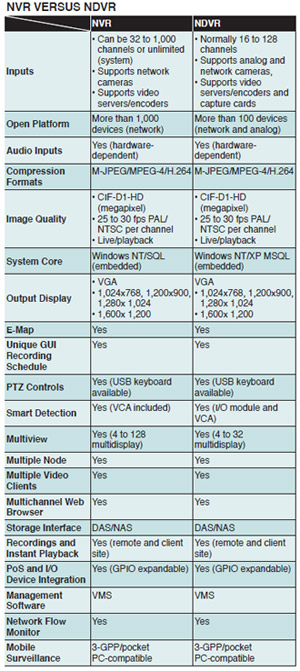An NDVR emulates the NVR's front-end operation and core processing, overcoming DVR shortcomings. NDVRs achieve superior network transmission and support real-time streaming at 30 fps to different remote sites or client Web browsers. A network-enabled DVR could not support such real-time applications, but these are now possible with the NDVR. An NDVR uses server hardware with VMS, enabling wireless 3-GPP transmission and HTML image transfer, conveniently fulfilling remote monitoring needs.
 NDVRs also offer advantages for back-end recording and video playback. While DVRs were restricted by local storage limits, NVRs have large amounts of remote storage, with cloud storage soon becoming a reality. NDVR design not only supports local storage to IDE or SCSI drives, but also enables mirrored storage approaches, as well as direct attached storage or network-attached storage (NAS). This flexibility is more than either a DVR's or NVR's storage and playback capabilities.
NDVRs also offer advantages for back-end recording and video playback. While DVRs were restricted by local storage limits, NVRs have large amounts of remote storage, with cloud storage soon becoming a reality. NDVR design not only supports local storage to IDE or SCSI drives, but also enables mirrored storage approaches, as well as direct attached storage or network-attached storage (NAS). This flexibility is more than either a DVR's or NVR's storage and playback capabilities.
Another improvement of NDVRs is better integration with third-party security systems and information security systems. NDVR SDKs are more open than closed DVRs and proprietary NVRs, giving end users more convenience and control over the video surveillance interface.
The differences between server-based NVRs and DVRs have resulted in varying applications. For increased competitiveness, the design of NDVR software and hardware has emerged in the wake of DVR and NVR usage shortcomings.
NDVR VERSUS NVR
After understanding how the NDVR came to be and its design concept, what are the true differences between NVRs and NDVRs? Before comparing the two, it is important to make a distinction between NDVRs and hybrid DVRs. There are storage solutions on the market which use Linux or Windows with four to 16 channels of analog and IP inputs, along with remote monitoring capabilities. These are much like network-enabled DVRs, but in terms of functionality and online management, they do not measure up to NDVRs.
The table below shows that the greatest difference between NDVRs and NVRs is not so much their features, but how they are applied and efficiently managed. The pure IP approach of the NVR has some inflexible shortcomings in real-world applications. Therefore, NDVR selection depends on actual installation needs. For example, NDVRs do not require a large number of embedded audio/video recording servers but can accommodate both IP and analog signals. Equipment selection, thus, depends on whether the system architecture can support user or site needs.